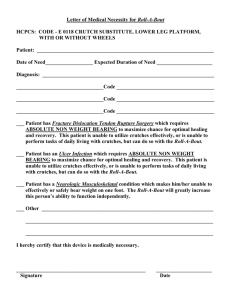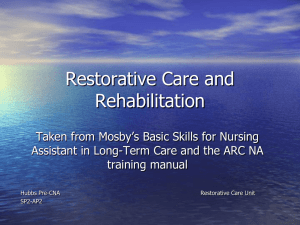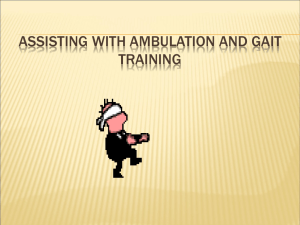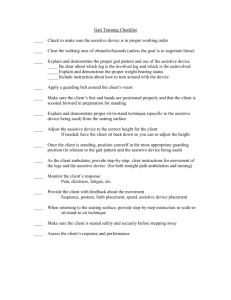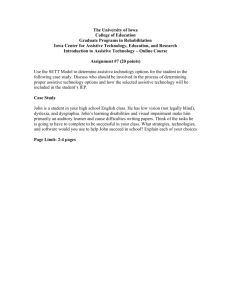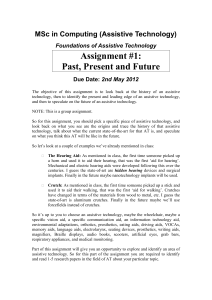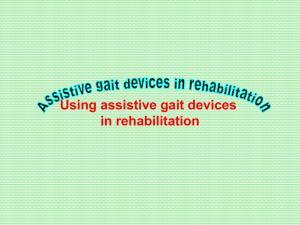ASSISTIVE DEVICES FOR AMBULATION
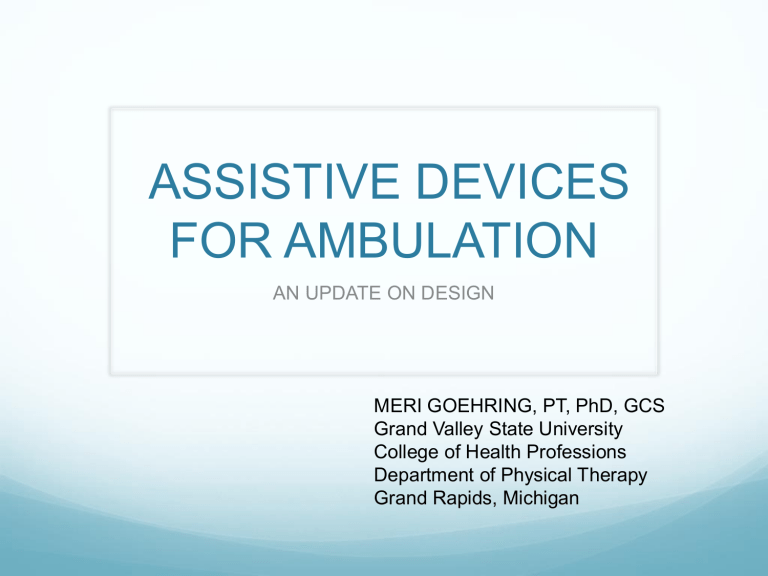
ASSISTIVE DEVICES
FOR AMBULATION
AN UPDATE ON DESIGN
MERI GOEHRING, PT, PhD, GCS
Grand Valley State University
College of Health Professions
Department of Physical Therapy
Grand Rapids, Michigan
Background information
The United States Census Report 2008 1
More than 10 million people age 15 or older used a cane, crutches or a walker for at least six months
More than 8 million adults used an assistive device for longer than six months
More than 15% of those using ambulation devices over 65 years of age used an ambulation assistive device for more than six months
With the rapidly aging population, more assistive devices will be used.
Objectives
Are these assistive devices safe?
What devices are new on the market?
What are the uses for these devices?
Improved balance and stability
Reduce pain or injury to one or both lower limbs by reducing the vertical load
Compensate for muscle weakness, sensory loss or other limb injury pathology
Fit of Device
Poor fitting of any assistive and/or improper training of how to use the device can lead to problems. These include:
Inefficient gait pattern
Injury to other parts of the body
Increased risk for falls
Increased cost with little to no benefit
Research on Assistive
Devices
Youdas, Kotajarvi, et. al., 2005 study indicated that healthy subjects could be taught to reduce weight bearing by 50% with axillary or forearm crutches, but this was much more challenging with a wheeled walker or cane.
4
Take home message? Gait training requiring reduced weight bearing may be difficult, especially with walkers, or canes.
Research on Assistive
Devices
Stevens JA, Thomas K, et al. in 2009 studied United
States emergency room records within a year, finding that 45,312 older adult fall injuries were associated with walking aids. Walkers were associated with seven times as many injuries as canes.
5
Certainly, more frail older adults use walking devices and are more likely to fall.
Take home message? People may have problems using walking aids safely and effectively. They may benefit from a comprehensive falls prevention program.
Research on Assistive
Devices
There is some evidence that assistive devices may inhibit natural balance reactions.
Bateni and Maki in 2004 found that use of a standard walker or straight cane interfered with compensatory stepping reactions when normal subjects underwent large lateral perturbations.
6
Take home message? Normal stepping reactions that occur with a fall may be difficult when using a walker or cane when large and unpredictable balance disturbances occur.
Canes
Research on canes suggest that there is a need for trained health care professionals to be involved for proper fit and function.
A comprehensive balance program should be provided whenever an assistive device is recommended.
Canes are very useful for unweighing a limb with painful osteoarthritis
A tripod may add stability and efficiency
Able Tripod latex rubber base for canes
Portable
Hurry Cane
Stable, flexible base
Hurry Cane Base
Reported to add stability.
No research available.
Internet sales and marketing phenomenon.
Cost is $40.00 to $70.00 based on availability of promotional deals and shipping costs.
Crutches
Research on crutches indicate that axillary crutches may provide more stability than forearm crutches.
Crutches may be better than walkers with sternal precautions.
Spring loaded crutches may reduce the ‘jarring’ of crutches but does not reduce the energy required to walk with crutches.
There are some new designs for forearm crutches and for standard axillary crutches.
Strong-Arm Crutch
Design that shifts weight from the wrist to the forearm
Ergonomic hand grip with an offset hand component
Forearm component which contours the UE limb to provide increased lateral support compared to that offered by standard forearm crutches.
Crutches
Mobi-legs crutches
Mobi-legs
The saddle grips naturally and is well-ventilated for continuous air circulation.
Articulated saddle design pivots and rotates in tandem with body movement and features 1 1/4" of built-in dampening. It maintains full contact and will not abrade the soft tissue. The pliable membrane sling provides suspended support, creating a rest for the underarm of unparalleled comfort.
Mobi-legs
Ergonomic Handgrips contour to the hand, maintain a natural wrist angle and evenly distribute load across the palm. Ergonomic
Handgrips are specifically left/right handed.
Mobi-legs
The legs are offset to provide hip clearance and limit the potential for tripping.
Fully adjustable height and arm length to properly fit
96% of all adults 4’9" to 6’4" up to 300lbs.
Mobi-legs
Rocker Feet with overmolded, natural rubber pads maintain full contact throughout the stride and are proven to require less exertion.
Walkers
Research on walkers indicates that consideration of the environment as well as the caregivers should influence the decision of type of walker chosen.
Inappropriate use of walkers may lead to forward bent posturing.
Gait velocity slows when standard, non-wheeled walkers are used with individuals with Parkinson disease.
A wheeled walker may be more energy efficient, but only if it is used correctly.
Walkers
Braking devices for standard walkers with wheels on back legs.
These brakes engage with weight bearing making the walker more stable, but easy to move forward when walking.
Braking devices for standard walkers
Rollator walker; seated 4 wheel walker
Walkers: Knee walkers or rollabouts
Walkers
Stair climbing walker manufactured in
China
Walking Poles
Research on walking poles
Study by Willson JM, Torry JMR, et al.2001
The use of walking poles enabled subjects to walk at a faster speed with reduced vertical ground reaction forces, vertical knee joint reaction forces, and reduction in the knee extensor angular impulse and support moment, depending on the poling condition used.
Walking poles
Summary
Potential use Advantages Assistve device price
Strong arm $50 to
$60 each
More lateral support needed
Shits weight from wrist to forearm
Disadvantages
Not easily available, more expensive
Mobilegs $50 to
$130/pair
Long term use or need stability
Fit and comfort
Abletripod cane base $20
Walking poles $18 to $50 each
Knee walker
$170 to $300
Rollator walker
$170 to $600
Stair walker (not available)
More stability
Active patients wanting stability
Non-weight bearing ankle-foot
Long term walker use, provides seat
Provides stable base
Folding, wide variety of types
Freedom of mobility
Durable, brakes, seat
Long term stair use Level and stair use possible
More expensive than traditional crutches
Amount of stability unknown
Not as supportive as other devices
Not on stairs, more expensive
Heavier, more expensive
Not currently available in USA
References
1. Kaye HS, Kang T, LaPlante MP. Mobility Device use in the United States. Washington, DC: United
States Department of Education. National Institute on Disability and Rehabilitation Research; 2000:60 p.
2. Faruqui SR, Jaeblon T. Ambulatory assistive devices in orthopaedics: Uses and modifications. J Am
Acad Orthop Surg . 2010;18(1):41-50.
3. Salminen A, Brandt A, Samuelsson K, Toytari O, Malmivaara A. Mobility devices to promote activity and participation: A systematic review.
J Rehabil Me d. 2009;41:697-706.
4. Youdas JW, Kotajarvi B.J. P, D.J., Kaufman KR. Partial weight-bearing gait using conventional assistive devices.
Arch Phys Med Rehabi l. 2005;86:394-398.
5. Stevens JA, Thomas K, Teh L, Greenspan AI. Unintentional fall injuries associated with walkers and canes in older adults treated in U.S. emergency departments.
J Am Geriatr So c. 2009;57(8):1464-
1469.
6. Bateni H, Maki BE. Assistive devices for balance and mobility: Benefits, demands, and adverse consequences.
Arch Phys Med Rehabi l. 2005;86(1):134-145.
7. Bateni H, Heung E, Zettel J, McLlroy WE, Maki BE. Can use of walkers or canes impede lateral compensatory stepping movements?
Gait Postur e. 2004;20(1):74-83.
8. Wellmon R, Pezzillo K, Eichhorn G, Lockhart W, Morris J. Changes in dual-task voice reaction time among elders who use assistive devices.
J Geri Phys Ther . 2006;29(2):74-80.
References
9. McCulloch K. Attention and dual-task conditions: Physical therapy implications for individuals with acquired brain injury.
J Neurol Phys Ther . 2007;31(3):104-118.
10. Thomas B, Connelly D, Laliberte-Rudman D. The impact and use of walkers among older adults: A pilot.
Phys Occup Ther Geriatr . 2008;27(1):36-72.
11. Pape TL, Kim J, Weiner B. The shaping of individual meanings assigned to assistive technology: A review of personal factors.
Disabil Rehabi l. 2002;24(1):5-20.
12. Liu H, (Howe), Eaves J, Wang W, Womack J, Bullock P. Assessment of canes used by older adults in senior living communities.
Arch Gerontol Geriat r. 2011;52(3):299-303.
13. Hall CD, Jensen JL. The effect of cane use on the compensatory step following posterior perturbations.
Clin Biomech (Bristol, Avon ). 2004;19(7):678-687.
14. Jones A, Silva PG, Silva AC, et al. Impact of cane use on pain, function, general health and energy expenditure during gait in patients with knee osteoarthritis: A randomised controlled trial.
Ann Rheum Di s.
2012;71(2):172-179.
15. Allet L, Leemann B, Guyen E, et al. Effect of different walking aids on walking capacity of patients with poststroke hemiparesis.
Arch Phys Med Rehabi l. 2009;90(8):1408-1413.
16. Nolen J, Liu H, Liu H, McGee M, Grando V. Comparison of gait characteristics with a single-tip cane, tripod cane, and quad cane.
Phys Occup Ther Geriatr . 2010;28(4):387-395.
17. Liu H. Assessment of rolling walkers used by older adults in senior-living communities.
Geriatr Gerontol
Int . 2009;9(2):124-130.
References
18. Liu H, Grando V, Zabel R, Nolen J. Pilot study evaluating fear of falling and falls among older rolling walker users... including commentary by hakim RM, huang M, and pearson B.
Int J Ther
Rehabil . 2009;16(12):670-677.
19. Pasquini SM, Peterson ML, Rattansi SM, et al. The impact of assistive device prescription on gait following total knee replacement.
J Geriatr Phys Ther . 2010;33(2):64-70.
20. Cubo E, Moore CG, Leurgans S, Goetz CG. Wheeled and standard walkers in parkinson's disease patients with gait freezing.
Parkinsonism Relat Disor d. 2003;10(1):9-14.
21. Gupta RB, Brooks D, Lacasse Y, Goldstein RS. Effect of rollator use on health-related quality of life in individuals with COPD.
Ches t. 2006;130(4):1089-1095.
22. Priebe JR, Kram R. Why is walker-assisted gait metabolically expensive?
Gait Postur e.
2011;34(2):265-269.
23. Goehring M, Kenyon L. Axillary or forearm crutches: Comparing postural sway in single leg stance and perceptions of safety.
J Acute Care Phys Ther . 2011;2(2):72.
24. Sanders LHA, Chen W, Cindric SE, Newman MAJ. Sternotomy and crutches.
Interactive
CardioVascular and Thoracic Surger y. 2011;13(2):237-239.
25. Segura A, Piazza SJ. Mechanics of ambulation with standard and spring-loaded crutches.
Arch
Phys Med Rehabi l. 2007;88(9):1159-1163.
26. Zhang Y, Liu G, Xie S, Liger A. Biomechanical evaluation of an innovative spring-loaded axillary crutch design.
Assist Techno l. 2011;23(4):225-231.
27. Willson JM, Torry JMR, et al. Effect of walking poles on lower extremity gait mechanics Medicine and Science in Sports and Exercise 2011 ; 33 (1).
